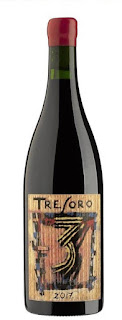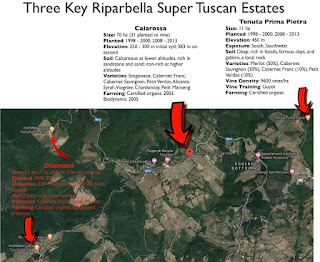As Marina, our host, explained it, Brunello di Montalcino and the Super Tuscans burst on the scene around the same time in the 1970s. They thought it would be a good exercise to trace the steps of the Super Tuscan movement and explore, in our discussion, whether there were any learnings for Brunello di Montalcino from this path.
Ugo began with a history of the Super Tuscan movement and Sebastian filled in some of the details. Then Ugo turned to the story of the founding of Tenuta Prima Pietra. His boss, Massimo Ferragamo, wanted to build a winery in the Super Tuscan zone and went to Bolgheri but was unable to find a property. While in the region, his adviser indicated that Sassicaia was such a success because it was on the highest ground in Bolgheri. So, as Massimo expanded his property search outside of Bolgheri, he had high-elevation as one of his key selection criteria. And so he came upon this 200-ha property on the hill in Riparbella (at that time only 7 ha was devoted to vines) and chose it for his Tuscan dream.
At this time Ugo remoted-in the winemaker from the Pietra Prima property to talk about the estate. She discussed the longer growing season resulting from a combination of the Mediterranean climate, the abundance of light, the constant wind, and the day-night temperature differentials. She mentioned the 500 mm of rain per year which was insufficient in the region and dictated irrigation. Of the 50 hectares of vineyards, 32 ha are currently irrigated.
Ugo also shared some news with us. Tenuta Prima Pietra had banded together with two like-minded wineries (Caiarossa and Duemani) in the area to promote Riparbella as a wine region. Their first initiative towards this end is a cooperative wine called Tresoro. This wine is a blend of Merlot, Cabernet Franc, and Cabernet Sauvignon grown on each estate. The grapes were vinified and aged at each estate and then sent to Caiarossa for blending and bottling.
I have written extensively on Tuscan Merlots but had not encountered this region, or these wineries, prior to this presentation. My interest was piqued.
Riparbella is located in Val de Cecina (shown in the map below) which "extends along the River Cecina in the south of the Province of Pisa" and also including portions of the provinces of Grosetto, Liivorno, and Sienna. The valley is hilly in the hinterland and mostly flat near the mouth of the river.
Riparbella is located due north of Bolgheri, with the mentioned estates located on high ground in an arc to the north of the actual town.
 |
| Location of Riparbella wineries (represented by Caiarossa) relative to Bolgheri |
The area is perfect for grape growing, with plenty of sunlight, a Mediterranean climate, a steady wind blowing in off the sea (modifying the temperatures and ventilating the vines), and significant diurnal temperature variation. These conditions allows for a longer growing season -- allowing the grapes to reach full maturity -- while retaining the acidity required for freshness and aging.
The chart below shows the distribution of the estates and some of their vital statistics.
Duemani
The leftmost of the three -- Duemani -- is spread over two distinct locations. The estate is owned by Elena Calli and Luca d'Attoma, the latter a highly respected Tuscan winemaker, and was established on the Tuscan coast because the owners wanted to produce wines from their favorite grape varieties (Cabernet Franc, Syrah, and Merlot). They decided to farm biodynamically in order to respect and preserve the environment. The stated goal of the estate is "to produce wines that are fine, clean, direct, and delicious with unique and recognizable character."
The Duemani partners found the original 7 ha in 2008 and planted three vineyards on the amphitheatre-like setting: Cabernet Franc at the top; Merlot towards the bottom; and Syrah in a small, goblet-shaped vineyard in the middle of the slope. This rocky, dry-soil vineyard is the heart of the estate.
In 2014 they planted 3 more ha of Cabernet Franc at 383 m. Today they have a total of 12 ha under vine.
The Duemani portfolio is all red wines with the exception of a 100% Rosé Syrah. Two of the remaining wines are 100% Cabernet Franc, one is a Merlot/Cabernet Franc equal parts blend, one a 100% Syrah, and the last a 100% Grenache. Wines are fermented in amphorae, cement vats, conical French oak tanks, and French oak barriques and are aged in similar vessels plus tonneaux.
Tenuta Prima Pietra
The rightmost of the three is Tenuta Prima Pietra, owned by Massimo Ferragamo (who also owns Castiglione di Bosco in Montalcino). Organic farming is at the estate's core in that it "provides the best way to maintain the balance required in a natural vineyard" and allows the vine to be "consistent and sincere, a proud ambassador of the vintage, harvest, the terroir of the estate and the personality of each single varietal."
The composition of the estate's wine mirrors the distribution of cultivars in the vineyard. The grapes are vinified (separately) in steel tanks and then aged (again, separately) in French oak for 18 months before blending prior to bottling.
Caiarossa
Caiarossa, the largest of the three estates, is owned by Eric Albhda Jelgersma, who also owns the Bordeaux estates Chateau Giscours and Chateau du Tertre. Biodynamic farming is at this estate's core, as manifested in its cultivation activities (animal and grain manure and fermentation residue, biodynamic preparations, cover crops) and vine-protection initiatives (stimulation of the natural defences of the plant, spray with low doses of sulfur and copper, pesticides based on natural mineral substances, "sexual confusion" to control insect population).
The wine lineup includes a Viognier - Chardonnay blend, a late picked Petit Manseng, a blend that incorporates all of the estates red grapes, a Bordeaux blend plus Syrah, and a Sangiovese wine with small additions of Cabernet Franc and Merlot.
*******************************************************************************************************
Discovering this region and these estates was an unforeseen effect of attending the Podere le Ripi talks. They stepped out of the box and showed us something totally new. Kudos to the team.
As for the region and the estates, it will be interesting to see how they grow and evolve. I look forward to going into the area, after things have gotten back to some level of normalcy, and tasting their wines on site.
©Wine -- Mise en abyme





No comments:
Post a Comment